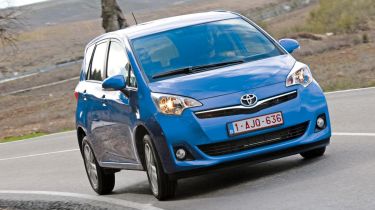Toyota Verso-S
Toyota's return to the supermini-MPV sector, the Verso-S, promises to be the smallest and lightest car in its class

The Verso-S certainly is a ‘mini’ MPV – it’s the shortest and lightest car in this sector – but clever packaging means there’s lots of space for passengers and luggage. It’s more comfortable and refined than most rivals, while the cabin could be from the class above. The 1.33-litre engine is underpowered, yet this is still a strong addition to Toyota’s small car line-up.
Five years after the demise of the Yaris Verso, Toyota is re-entering the supermini-MPV market with this: the Verso-S. It’s designed to be one of the lightest and most compact people carriers on the market, but is the newcomer as versatile as its name suggests?
The styling takes cues from the firm’s innovative iQ city car – especially the triangular lights and squared-off grille. But the tall, boxy shape is functional rather than head-turning. Inside, Toyota has done a great job of transferring the quality feel of bigger cars such as the Avensis into this smaller package.
Making its debut on the Verso-S is Toyota Touch – an attractive six-inch touchscreen that controls media functions. From May, it will also feature an optional sat-nav. It’s a great piece of kit, and removes switchgear clutter on the short centre console.
In true MPV style, the Verso-S makes the most of the available space. There’s a multitude of storage cubbies, including a triple-layered glovebox. Plus, the trick boot floor drops down to accommodate tall items or slides up to give a flat load area with the rear seats folded. This frees up the maximum 1,388 litres of storage space.
Our T-Spirit model also comes with one of the largest sunroofs fitted to any car on the market – a whopping 1.2 metres in length. It’s glued to the chassis frame to save weight, and prevents the interior from feeling cramped.
Used - available now

2023 Audi
A3 Sportback
19,678 milesManualPetrol1.0L
Cash £17,324
2024 Audi
A3 Sportback
30,795 milesManualPetrol1.5L
Cash £19,750
2024 Audi
A3 Sportback
17,333 milesManualPetrol1.0L
Cash £18,811
2021 Mercedes
A-Class
41,806 milesAutomaticDiesel1.5L
Cash £16,051There’s only one engine option – the 1.33-litre VVT petrol from the iQ. It’s mated to a choice of a six-speed manual box or a CVT paddleshift auto. Our car had the former, but short ratios mean it revs quite high on the motorway, making longer journeys tiring.
Performance is good in town, although getting up to speed is hard work as there’s only 123Nm of torque. The soft, composed ride and light steering are tailored to city driving – as are the narrow dimensions. Parking is hassle-free, especially on TR spec and above, as a reversing camera is standard.
There’s no hybrid technology, but this is one of the cleanest petrol-engined small cars around – largely because it tips the scales at only 1,070kg. Combined fuel returns of 51.4mpg and CO2 emissions of 127 g/km put it ahead of rivals like the Nissan Note and Kia Venga. So while it’s not revolutionary, the Verso-S is a worthy addition to the class.
Rival: Honda Jazz
The updated Jazz has a loyal customer base – although the new Toyota will push it hard. Better quality and an incredibly flexible seating layout set the Honda apart, while there’s a 104g/km hybrid coming, too.







